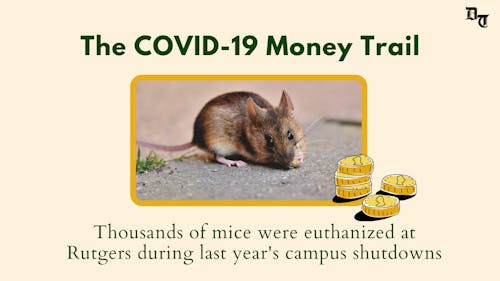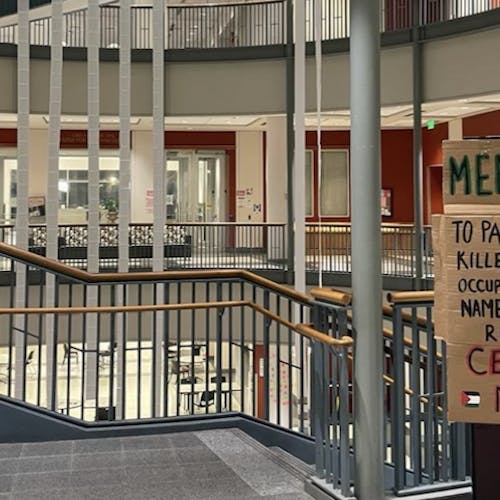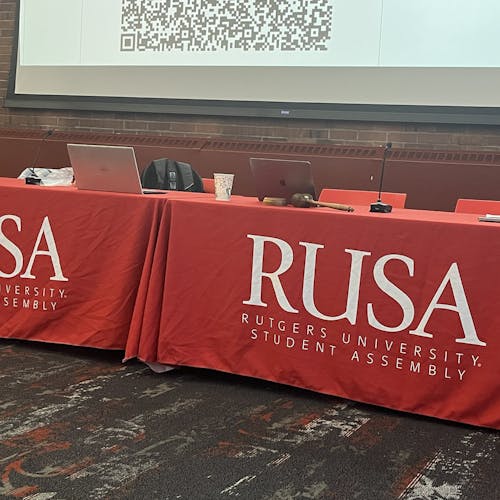Special report: Thousands of mice were euthanized at Rutgers during last year's campus shutdown

As many as 23,000 experimental mice were euthanized in early 2020 by the staff of Rutgers Biological and Health Sciences (RBHS) in a little-known tragic result from the campus shutdown that followed the outbreak of the coronavirus disease (COVID-19) pandemic, according to records obtained by The Daily Targum as part of a six-month investigation into University spending during the pandemic.
Until now, Rutgers officials have not acknowledged the killings, and they still will not confirm the exact number of mice they eliminated. The advocacy group People for the Ethical Treatment of Animals (PETA) initially alleged in a June 2020 letter to former University President Robert Barchi that a whistleblower had “disturbing evidence” of Rutgers ordering suspension of all “non-essential” research and the destruction of animals from that research.
“Rutgers University’s use of intelligent and sensitive animals in experiments as though they were nothing more than disposable laboratory equipment is shameful,” PETA Vice President Shalin Gala said then. PETA’s allegation received little to no press attention at the time, and no one could confirm the extent of the killings.
But in a document obtained by the Targum from the state in a public records request, Rutgers Chief Financial Officer J. Michael Gower explicitly mentions the number of mice the University eliminated. His reference is buried in the fine print of an application for emergency COVID-19 aid that Gower filed with the state of New Jersey on Aug. 28, 2020.
In that application, Gower provided details on some $30.8 million that RBHS claimed to have lost due to the pandemic, and for which the University was seeking to get reimbursed.
As reported by the Targum on Sept. 19, Rutgers received nearly $365 million in government COVID-19 grants during the past 18 months, including nearly $80 million from the state of New Jersey.
One of the losses Gower listed on his excel sheet summary, on line 67, was for $1.15 million.
“Loss of research animals required for student/postdoc training,” the explanatory notes to that item state. “RBHS was forced to eliminate 4,600 cages of mice, each containing an average of five mice. Assuming an average cost of $50/mice.”
When the Targum asked at the end of September for details about the disposal of such a large number of mice, the Rutgers Office of Research denied that any had been euthanized or that the pandemic affected their ability to provide a high standard of animal care and welfare.
“In line with peer research universities across the nation, we prepared for multiple contingencies as part of our emergency pandemic response plan,” the Office for Research said in an email. “This planning included a worse-case scenario that may have led to the euthanization of animals should the food and other critical supply chains have been severely impacted by the pandemic. Fortunately, there were no such disruptions and we never reached this stage of the emergency plan.”
When the Targum repeatedly pointed out that several other lines in the same financial application detailed the “culling” of research animals by RBHS, University spokesperson Dory Devlin acknowledged that research animals had been euthanized to some degree following the pandemic shutdowns, but would not say exactly how many.
Devlin conceded that the University would be receiving the $1.15 million from the state of New Jersey as compensation for the lost research animals.
“During the ramp-down of research last year, principal investigators (PI) were asked to scale down or stop research not deemed critical,” Devlin said in an email. ”Mitigating measures, including halting breeding and not starting new studies, as stated before, significantly reduced any need for euthanization. Unfortunately, ending studies early can lead to euthanization. When these decisions are made by a PI …, Rutgers and its researchers fully comply with all requirements of the Animal Welfare Act, Public Health Service Policy on Humane Care and Use of Laboratory Animals.”
Despite the University stating that euthanizing research animals during this time was necessary due to the major decrease in research, there have still been concerns about research animals being labelled as nonessential.
“The COVID-19 pandemic should be a moral and scientific reckoning for the school, which conducts deadly experiments on animals it keeps inside small steel cages,” PETA’s Gala said. “If it can’t prove that the animals used in its experiments are essential — and its response to the pandemic indicates that they’re not — it must not be permitted to continue squandering taxpayer money on animal tests once the pandemic is over.”
This isn’t the first time there has been concern about the use of research animals at the University. A decade ago, a Rutgers student was put on probation for removing research animals from a University lab, said Patricia Bombelyn, an attorney who represented the student in this case.
Bombelyn said the student had entered a Rutgers building through an unlocked door where they found five lab rats on a table. The student had removed the animals from the building and took care of them until they could be returned, she said.
“Rutgers took a very harsh view about it, and disciplined my client with suspension for the remainder of that school year,” Bombelyn said.
The euthanization of experimental animals deemed nonessential was a widespread phenomenon during the pandemic. Faculty at Johns Hopkins University, Stanford University, the University of California, Berkeley, the University of Washington and the University of Michigan were told to focus on depopulating these animals during this time, according to PETA's website.
"We are asking our care staff to do the work of two people every day (during the pandemic)," said Eric Hutchinson, director of research animal resources at Johns Hopkins University, according to an article from Science. "It's grim and sad, but it's something that needs to done."
In another instance, lab staff at the University of Pennsylvania’s Perelman School of Medicine were instructed to euthanize 200 mice as quickly as possible, according to the article.
“PETA has documented how more than 80 universities and research institutes in the U.S. have been on a killing spree due to (COVID-19), ‘ramping down’ their laboratories in a matter of weeks and killing thousands of animals in the process,” Gala said. “That’s how quickly these animals went from purportedly being ‘essential tools to cure human diseases’ to instead now becoming simply disposable garbage.”
According to guidelines from the American Veterinary Medical Association, one of the most common and acceptable ways to euthanize laboratory animals is through administering gases such as carbon dioxide or nitrous oxide as inhalants. Additionally, all selected methods of euthanization should aim to minimize distress in these research animals.
“As eliminating all sources of distress may not be practical or possible, the selected method of euthanizing rodents should minimize these sources of potential distress,” the guidelines state.



